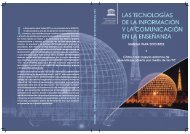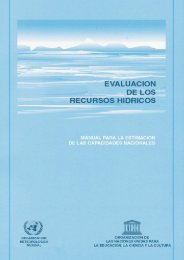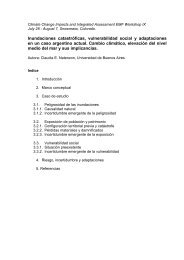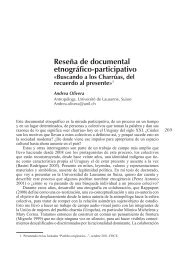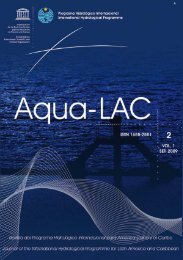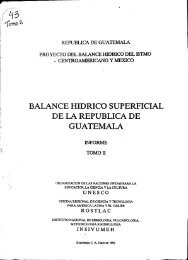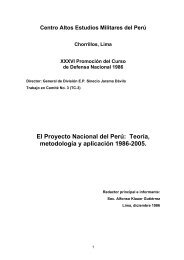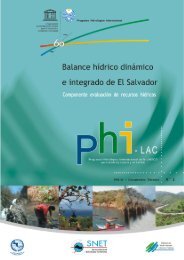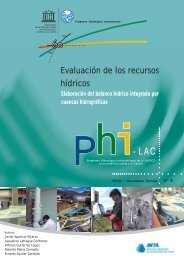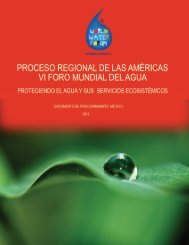- Page 1 and 2: COLECCIÓN GLACIARES, NEVADOS Y MED
- Page 4: Glacia res, nieves y hielos de Amé
- Page 7 and 8: MINISTERIO DE MINAS Y ENERGÍA Inst
- Page 9 and 10: Cambio climático y glaciares: de l
- Page 11 and 12: Observaciones geodésicas satelital
- Page 13 and 14: vestigación para el Desarrollo (IR
- Page 15 and 16: G L A C I A R E S , N I E V E S Y H
- Page 17 and 18: G L A C I A R E S , N I E V E S Y H
- Page 22 and 23: L l i n á s Ta m a y o • M e n e
- Page 24 and 25: L l i n á s Ta m a y o • M e n e
- Page 26 and 27: L l i n á s Ta m a y o • M e n e
- Page 28 and 29: L l i n á s Ta m a y o • M e n e
- Page 30 and 31: L l i n á s Ta m a y o • M e n e
- Page 32 and 33: L l i n á s Ta m a y o • M e n e
- Page 34 and 35: L l i n á s Ta m a y o • M e n e
- Page 36 and 37: L l i n á s Ta m a y o • M e n e
- Page 38 and 39: L l i n á s Ta m a y o • M e n e
- Page 40 and 41: L l i n á s Ta m a y o • M e n e
- Page 42 and 43: L l i n á s Ta m a y o • M e n e
- Page 44 and 45: L l i n á s Ta m a y o • M e n e
- Page 46 and 47: L l i n á s Ta m a y o • M e n e
- Page 48 and 49: L l i n á s Ta m a y o • M e n e
- Page 50 and 51: L l i n á s Ta m a y o • M e n e
- Page 52 and 53: L l i n á s Ta m a y o • M e n e
- Page 54 and 55: L l i n á s Ta m a y o • M e n e
- Page 56 and 57: L l i n á s Ta m a y o • M e n e
- Page 58 and 59: L l i n á s Ta m a y o • M e n e
- Page 60 and 61: L l i n á s Ta m a y o • M e n e
- Page 62 and 63: Análisis del retroceso del glaciar
- Page 64 and 65: I t u r r a s p e • U r c i u o l
- Page 66 and 67: I t u r r a s p e • U r c i u o l
- Page 68 and 69: I t u r r a s p e • U r c i u o l
- Page 70 and 71:
I t u r r a s p e • U r c i u o l
- Page 72 and 73:
I t u r r a s p e • U r c i u o l
- Page 74 and 75:
I t u r r a s p e • U r c i u o l
- Page 76 and 77:
I t u r r a s p e • U r c i u o l
- Page 78 and 79:
Variaciones glaciares y disponibili
- Page 80 and 81:
C o n d o m • S u á r e z • C
- Page 82 and 83:
C o n d o m • S u á r e z • C
- Page 84 and 85:
C o n d o m • S u á r e z • C
- Page 86 and 87:
C o n d o m • S u á r e z • C
- Page 88 and 89:
C o n d o m • S u á r e z • C
- Page 90 and 91:
C o n d o m • S u á r e z • C
- Page 92 and 93:
Glaciares Santa Isabel y el Cocuy (
- Page 94 and 95:
C e b a l l o s • To b ó n • A
- Page 96 and 97:
C e b a l l o s • To b ó n • A
- Page 98 and 99:
C e b a l l o s • To b ó n • A
- Page 100 and 101:
C e b a l l o s • To b ó n • A
- Page 102 and 103:
C e b a l l o s • To b ó n • A
- Page 104 and 105:
C e b a l l o s • To b ó n • A
- Page 106 and 107:
C e b a l l o s • To b ó n • A
- Page 108 and 109:
C e b a l l o s • To b ó n • A
- Page 110 and 111:
C e b a l l o s • To b ó n • A
- Page 112 and 113:
C e b a l l o s • To b ó n • A
- Page 114 and 115:
C e b a l l o s • To b ó n • A
- Page 116 and 117:
Cambio climático y glaciares: de l
- Page 118 and 119:
M a r t í n e z G ü i n g l a rid
- Page 120 and 121:
M a r t í n e z G ü i n g l a se
- Page 122:
M a r t í n e z G ü i n g l a Ref
- Page 125 and 126:
G L A C I A R E S , N I E V E S Y H
- Page 127 and 128:
G L A C I A R E S , N I E V E S Y H
- Page 129 and 130:
G L A C I A R E S , N I E V E S Y H
- Page 131 and 132:
G L A C I A R E S , N I E V E S Y H
- Page 133 and 134:
G L A C I A R E S , N I E V E S Y H
- Page 135 and 136:
G L A C I A R E S , N I E V E S Y H
- Page 137 and 138:
G L A C I A R E S , N I E V E S Y H
- Page 139 and 140:
G L A C I A R E S , N I E V E S Y H
- Page 141 and 142:
G L A C I A R E S , N I E V E S Y H
- Page 143 and 144:
G L A C I A R E S , N I E V E S Y H
- Page 145 and 146:
G L A C I A R E S , N I E V E S Y H
- Page 147 and 148:
G L A C I A R E S , N I E V E S Y H
- Page 149 and 150:
G L A C I A R E S , N I E V E S Y H
- Page 151 and 152:
G L A C I A R E S , N I E V E S Y H
- Page 153 and 154:
G L A C I A R E S , N I E V E S Y H
- Page 155 and 156:
G L A C I A R E S , N I E V E S Y H
- Page 157 and 158:
G L A C I A R E S , N I E V E S Y H
- Page 159 and 160:
G L A C I A R E S , N I E V E S Y H
- Page 161 and 162:
G L A C I A R E S , N I E V E S Y H
- Page 163 and 164:
G L A C I A R E S , N I E V E S Y H
- Page 165 and 166:
G L A C I A R E S , N I E V E S Y H
- Page 167 and 168:
G L A C I A R E S , N I E V E S Y H
- Page 169 and 170:
G L A C I A R E S , N I E V E S Y H
- Page 172 and 173:
Acondicionamiento físico previo a
- Page 174 and 175:
G o n z á l e z M o r a l e s •
- Page 176 and 177:
G o n z á l e z M o r a l e s •
- Page 178 and 179:
G o n z á l e z M o r a l e s •
- Page 180 and 181:
G o n z á l e z M o r a l e s •
- Page 182 and 183:
Desaparición de los glaciares en e
- Page 184 and 185:
G o n z á l e z • J o r d a n
- Page 186 and 187:
G o n z á l e z • J o r d a n
- Page 188 and 189:
G o n z á l e z • J o r d a n
- Page 190 and 191:
G o n z á l e z • J o r d a n
- Page 192 and 193:
G o n z á l e z • J o r d a n
- Page 194 and 195:
Reconstrucción climática en la Si
- Page 196 and 197:
To r r e s • G o n z á l e z •
- Page 198 and 199:
To r r e s • G o n z á l e z •
- Page 200 and 201:
To r r e s • G o n z á l e z •
- Page 202 and 203:
To r r e s • G o n z á l e z •
- Page 204 and 205:
To r r e s • G o n z á l e z •
- Page 206 and 207:
To r r e s • G o n z á l e z •
- Page 208 and 209:
To r r e s • G o n z á l e z •
- Page 210:
P a r t e 2 G L A C I A R E S Y A M
- Page 213 and 214:
G L A C I A R E S , N I E V E S Y H
- Page 215 and 216:
G L A C I A R E S , N I E V E S Y H
- Page 217 and 218:
G L A C I A R E S , N I E V E S Y H
- Page 219 and 220:
G L A C I A R E S , N I E V E S Y H
- Page 221 and 222:
G L A C I A R E S , N I E V E S Y H
- Page 223 and 224:
G L A C I A R E S , N I E V E S Y H
- Page 226 and 227:
Evaluación geométrica del casquet
- Page 228 and 229:
C á c e r e s • J o r d a n •
- Page 230 and 231:
C á c e r e s • J o r d a n •
- Page 232 and 233:
C á c e r e s • J o r d a n •
- Page 234 and 235:
C á c e r e s • J o r d a n •
- Page 236 and 237:
C á c e r e s • J o r d a n •
- Page 238 and 239:
C á c e r e s • J o r d a n •
- Page 240 and 241:
Ortofotomapa del Chimborazo y su va
- Page 242 and 243:
J o r d a n • G o n z á l e z
- Page 244 and 245:
J o r d a n • G o n z á l e z
- Page 246 and 247:
J o r d a n • G o n z á l e z
- Page 248 and 249:
J o r d a n • G o n z á l e z
- Page 250 and 251:
J o r d a n • G o n z á l e z
- Page 252 and 253:
J o r d a n • G o n z á l e z
- Page 254 and 255:
J o r d a n • G o n z á l e z
- Page 256 and 257:
J o r d a n • G o n z á l e z
- Page 258 and 259:
J o r d a n • G o n z á l e z
- Page 260 and 261:
J o r d a n • G o n z á l e z
- Page 262 and 263:
Aspectos relevantes de la actividad
- Page 264 and 265:
L o n d o ñ o Se han efectuado var
- Page 266 and 267:
L o n d o ñ o Figura 2. Sismograma
- Page 268 and 269:
L o n d o ñ o Análisis Hasta la f
- Page 270 and 271:
L o n d o ñ o Latitud (N). deg. La
- Page 272 and 273:
L o n d o ñ o Además de la activi
- Page 274 and 275:
L o n d o ñ o El modelo de Fernand
- Page 276 and 277:
L o n d o ñ o Figura 10. Modelo de
- Page 278:
L o n d o ñ o Referencias bibliogr
- Page 281 and 282:
G L A C I A R E S , N I E V E S Y H
- Page 283 and 284:
G L A C I A R E S , N I E V E S Y H
- Page 285 and 286:
G L A C I A R E S , N I E V E S Y H
- Page 287 and 288:
G L A C I A R E S , N I E V E S Y H
- Page 289 and 290:
G L A C I A R E S , N I E V E S Y H
- Page 291 and 292:
G L A C I A R E S , N I E V E S Y H
- Page 293 and 294:
G L A C I A R E S , N I E V E S Y H
- Page 295 and 296:
G L A C I A R E S , N I E V E S Y H
- Page 297 and 298:
G L A C I A R E S , N I E V E S Y H
- Page 299 and 300:
G L A C I A R E S , N I E V E S Y H
- Page 301 and 302:
G L A C I A R E S , N I E V E S Y H
- Page 303 and 304:
G L A C I A R E S , N I E V E S Y H
- Page 305 and 306:
G L A C I A R E S , N I E V E S Y H
- Page 308 and 309:
Observaciones geodésicas satelital
- Page 310 and 311:
M o r a P á e z • L ó p e z I s
- Page 312 and 313:
M o r a P á e z • L ó p e z I s
- Page 314 and 315:
M o r a P á e z • L ó p e z I s
- Page 316 and 317:
M o r a P á e z • L ó p e z I s
- Page 318 and 319:
M o r a P á e z • L ó p e z I s
- Page 320 and 321:
M o r a P á e z • L ó p e z I s
- Page 322 and 323:
M o r a P á e z • L ó p e z I s
- Page 324 and 325:
M o r a P á e z • L ó p e z I s
- Page 326 and 327:
M o r a P á e z • L ó p e z I s
- Page 328 and 329:
Red de detectores de flujos de lodo
- Page 330 and 331:
R a i g o s a • R o d r í g u e
- Page 332 and 333:
R a i g o s a • R o d r í g u e
- Page 334 and 335:
R a i g o s a • R o d r í g u e
- Page 336 and 337:
R a i g o s a • R o d r í g u e
- Page 338 and 339:
R a i g o s a • R o d r í g u e
- Page 340 and 341:
R a i g o s a • R o d r í g u e
- Page 342 and 343:
R a i g o s a • R o d r í g u e
- Page 344 and 345:
R a i g o s a • R o d r í g u e



